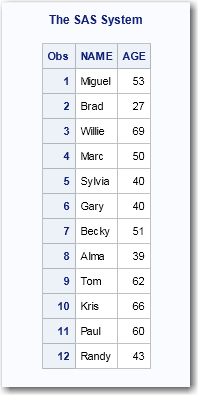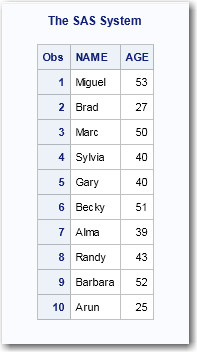OBS= System Option
Specifies the last record to process.
| Valid in: | configuration file, SAS invocation, OPTIONS statement, SAS System Options window |
| Category: | Files: SAS Files |
| PROC OPTIONS GROUP= | SASFILES |
| Supports: | All |
Syntax
OBS=n | nK
| nM | nG
| nT | hexX
| MIN | MAX
Syntax Description
- n | nK | nM | nG | nT
-
specifies a number to indicate when to stop processing, with n being an integer. Using one of the letter notations results in multiplying the integer by a specific value. That is, specifying K (kilobytes) multiplies the integer by 1,024; M (megabytes) multiplies by 1,048,576; G (gigabytes) multiplies by 1,073,741,824; or T (terabytes) multiplies by 1,099,511,627,776. For example, a value of
20specifies 20 rows or records. A value of3mspecifies 3,145,728 rows or records.
- hexX
-
specifies a number to indicate when to stop processing as a hexadecimal value. You must specify the value beginning with a number (0–9), followed by an X. For example, the hexadecimal value F8 must be specified as
0F8xto specify the decimal equivalent of 248. The value2dxspecifies the decimal equivalent of 45.
- MIN
-
sets the number to 0 to indicate when to stop processing.Interaction:When OBS=0 and the NOREPLACE option is in effect, SAS can still take certain actions because it actually executes each DATA and PROC step in the program, using no rows. For example, SAS executes procedures, such as CONTENTS and DATASETS, that process libraries or SAS data sets. External files are also opened and closed. Therefore, even if you specify OBS=0, when your program writes to an external file with a PUT statement, an end-of-file mark is written, and any existing data in the file is deleted.
Details
OBS= tells SAS when
to stop processing rows or records. For example, if OBS=10 is specified,
the result is 10 rows or records.
OBS= is valid for all
steps during your current SAS session or until you change the setting.
You can also use OBS= to control analysis of SAS data sets in PROC
steps.
In WHERE processing,
SAS first subsets the data, and then applies OBS= to the subset. The
FEDSVR engine does not have the concept of observation numbering from
the original data set. It sends back the number of rows requested,
numbered chronologically, regardless of where they occur in the data
set.
If SAS is processing
a raw data file, OBS= specifies the last line of data to read. SAS
counts a line of input data as one row, even if the raw data for several
SAS data set rows is on a single line.
Examples
Example 1: Using OBS= to Specify When to Stop Processing Rows
This example illustrates
the result of using OBS= to tell SAS when to stop processing rows.
This example creates a SAS data set that contains 15 rows, executes
the OPTIONS statement by specifying OBS=12, and then executes the
PRINT procedure. The result is 12 rows.
libname myfiles fedsvr server="d1234.us.company.com" port=2171 user=user1 pwd=pass1 dsn=basedsn; data myfiles.Ages; input Name $ Age; datalines; Miguel 53 Brad 27 Willie 69 Marc 50 Sylvia 40 Gary 40 Becky 51 Alma 39 Tom 62 Kris 66 Paul 60 Randy 43 Barbara 52 Virginia 72 Arun 25 ; options obs=12; proc print data=myfiles.Ages; run;
Example 2: Using OBS= with WHERE Processing
This example illustrates
the result of using OBS= along with WHERE processing. The example
uses the data set that was created in Example 1, which contains 15
rows, and assumes that the SAS session has been reset to the defaults
FIRSTOBS=1 and OBS=MAX. This example returns the first 10 rows that
meet the WHERE criteria.

